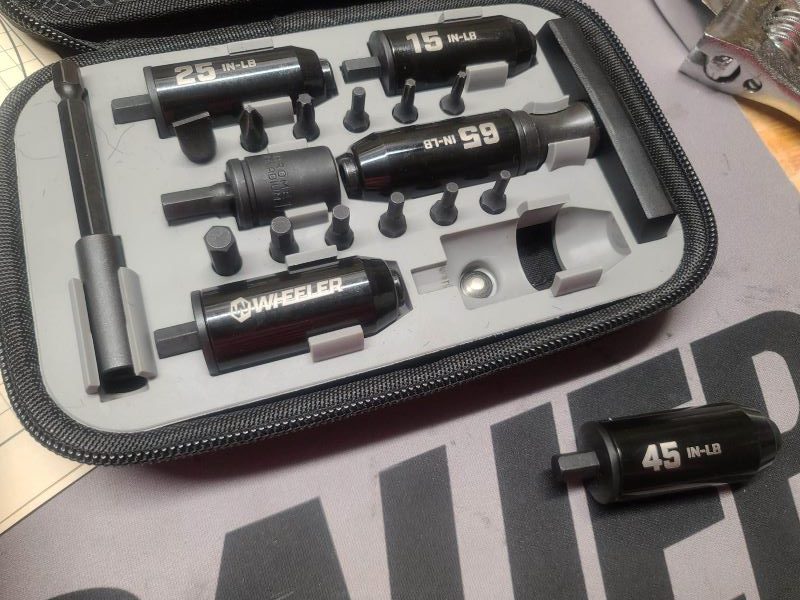Torque wrenches in the firearms world are not a want, they are a need. When it comes to scopes, actions, and rails, each product has a torque setting that is pushed by the manufacturer. Over-torquing can lead to breakage or shift in zero, and under-torquing can lead to loose items and just a bad day. Not only is the correct torque needed but also the correct bits and an easy way to transport all these things, as a lot of the same tools are needed both at home and on the range at a moment’s notice. To do all of this is the latest from Wheeler, the F.A.T. Stix Preset Torque Wrenches.
F.A.T. Stix

Uses
Torque Wrenches within the firearms world are needed both for precision bolt guns and the AR platform. They need to allow the proper torque limits, the proper bits that are strong enough to not strip, and both sockets and extended bits for hard-to-reach screws. Below are the specific torque settings needed for various firearms.
Bolt Gun
The bolt gun has torque settings on both the scope and the action/chassis itself. These various screws need to be properly torqued during installation and should be checked right before use. Military snipers actually keep a torque wrench in their kit and are instructed to verify torque before each employment of the firearm. This is good practice as rifles are often banged around during transport. Below are the specific torque settings needed on a precision bolt gun.
Note: Manufacturers push different torque limits, especially when it comes to scope mounts. ALWAYS check the manufacturer’s specs before installing. Including if you should use Loctite or not.
- Action Screws: 65in-lbs
- Top Scope Rings: 15-18in-lbs
- Rings to Base: 45in-lbs
- Rail to Action (if rail is not integrated onto the action): 15-18in-lbs
- Accessory Rails/ARCA Rails: 15-18in-lbs
- Forend: 15-18in-lbs
- Grip/Cheek Pieces/Various Chassis Components: 18 in-lbs.
It is worth it to note that a lot of times the rear action screw on a bolt gun chassis can be hidden under part of the grip or magwell. An extended bit is usually needed for this, and F.A.T. Stix provides that.
In the video below, a precision shooter goes over the same torque settings listed above. He is using the Wheeler Fat Wrench to torque. If you scroll down you will see the differences between the new F.A.T. Stix and the long trusted Wheeler Fat Wrench. This may help decide which product is right for you.
AR Platform
On the AR Platform a lot of the same torque settings are needed, such as on the scope. On the AR platform, many scope mounts that shooters use contain knobs instead of screws to tighten the scope down onto the base. The F.A.T. Stix includes a socket for these knobs and this socket can be placed into whichever preset torque wrench that you need for that specific mount.
Rail systems on the AR Platform often need a torque setting that can be handled using an inch-pound torque wrench. For instance, a recent IWI ARCA handguard install called for 45in-lbs on the rail screws. F.A.T. Stix has a preset 45 in-lbs and the bit.

Gas Blocks need specific torque as the screws are often small and can be easily stripped. However if they aren’t tightened down enough, a loose gas block means a downed rifle.
F.A.T. Stix Preset Torque Wrench Set Specs
- 15, 25, 35, 45, and 65-inch-pound torque limiters
- 12 popular bit sizes
- ½” socket and a ¼” drive bit extension
- Forged Steel Limiters
- Ergonomic T-handle
- Soft carry case
- Made in the USA
- Lifetime Guarantee
Wheeler Fat Wrench

Specs
- Handheld design
- Eight S2 tool steel bits
- Includes convenient storage case
- Made in the USA
- Lifetime Guarantee
What’s the difference between the Wheeler Fat Wrench and F.A.T. Stix?
Many know Wheeler and Torque from the trusted Wheeler Fat Wrench adjustable tool. While it serves its purpose well, there are some differences between the Fat Wrench and F.A.T. Stix that may change your mind about which product to purchase.
Adjustable vs Preset
The Fat Wrench is an adjustable torque wrench. Meaning that you adjust the wrench to the weight that you want. This can be viewed as a positive or a negative. On the positive side, it gives you a lot of in-between weights that a pre-set may not. Say you want 20in-lbs instead of a 25in-lbs preset. However, some can say that this is a negative due to the fact of mistakenly setting it to the wrong weight.
There is also a rumor going around that the Fat wrench can wear out if not turned down to zero for storage. In my opinion, that rumor is false due to springs just not working like that, such as in a magazine. According to Magpul, the spring geniuses, unloading your magazine each time actually wears down the spring due to constantly stretching and outstretching it. Leaving ammo in the mag causes less wear.
A preset wrench is set to one weight only, which means when that click goes off on the wrench as you’re tightening you know that you are at that pre-set weight.
Carry Cases
The Fat Wrench comes in a rounded plastic case with each bit and the wrench snapped into the plastic case. The case is held closed by one plastic tab. The F.A.T. Stix Preset Torque Wrench set comes in a soft zippered case with a mesh net to store additional tools in and each bit is held into a plastic molded insert. The soft zippered case is nice for throwing it in the front of a pack and not worrying about the case breaking. For this fact in itself, I personally keep a FAT Wrench on my bench and the F.A.T. Stix torque wrench set in my pack for matches.
Bits/Sockets/Limiters
The Fat Wrench comes with 8 bits. It does not come with a socket, extended bits, or a wrench without a limiter, which the F.A.T. Stix torque wrench set does. Sockets are needed for scope knobs and extended bits are needed for actions screws. Maybe the coolest feature about the F.A.T. Stix that the Fat Wrench doesn’t have is the ability to use the wrench without a torque limiter. This means that you can now use the same tool to remove torque screws as you should NOT be using a torque wrench during the removal of screws, only install. Both Wheeler Torque Tools come with tool steel bits which means that they won’t break or bend during torquing.
How to Properly Torque
Properly torquing anything is important. If you over torque you can strip screws or crush optics, under torque and things can come loose, torque unequally on each side of a mount and things can be shifted to one side of the other. All of these things can affect how your product works, in this case, how your firearm shoots and operates.
Another reason for applying the proper torque each time is that it will allow you to get as closely back to zero as you can. For instance, if you mount a scope to your rifle with 30 in-lbs one day, and the next day after removing it you decide to install it with 50in-lbs of torque, due to the placement of the optic after tightening in different weights, your zero will be off more than if you mounted the scope back in the same exact place with the same amount of torque.
Not only is the weight important, but also how you torque. “When a clicker wrench is pulled to the point of the torque setting, the lever inside the wrench rolls over a cam and hits the inside of the wrench handle wall. This effect makes the “click” sound, and tells the operator that they have reached the desired torque value.” -Hex Technology: The Clicker Wrench Guide
Some believe that that click, or lever hitting the inside of the wrench can actually apply backward force onto the screw as it clicks. Due to this, most users of click-type wrenches will use the wrench as such.
- Apply even and equal force to the wrench, with no jolting or coming in at an angle.
- Push until the wrench clicks.
- Remove the wrench and place it back into the screw applying torque just before it clicks.
Patterns are also very important. When torquing an item with multiple screws, patterning the screws is recommended. This means that the screws should be torqued in a star pattern or one in front, then the last one, then the second one, then the second to last, and so on and so forth. Doing this will apply even force as the torquing is complete and not torquing the front before even starting the rear. Almost like on a tire, you are supposed to ratchet down the lugs in a star pattern. Same as an optic. Hand-tighten everything first, then torque with a pattern.

Takeaways/Main Features
The large takeaways that I personally have loved when it comes to the F.A.T. Stix Preset Torque Wrench Set are:
- The quality of the bits. I have purchased cheap bits before and regretted it. I have twisted Hex bits, even broken them inside gas blocks which can be tough to remove. The steel tool bits are a very underappreciated, but needed, thing.
- Inside the case, I have a wrench that I can also use to remove things as well as torque them on due to being able to remove a limiter is a huge bonus. Many torque wrenches don’t allow the torque to be removed from the wrench entirely, so the modularity of the tool ensures that I don’t have to carry extra tools around.

Notice that the T-Handle is removable. This means that the F.A.T. Stix can also be used to remove screws, which many torque wrenches cannot do as it will damage the wrench. - The soft and zippered carrying case is needed as I want a wrench that I can throw into the pack that I throw around when doing a precision rifle match in a dirty desert. A plastic carrying case would break.
- Preset wrenches allow for never having to second guess where the proper torque is. Is it on the line? Above or below the line? Preset takes the guesswork out and doesn’t allow for oopsies.



